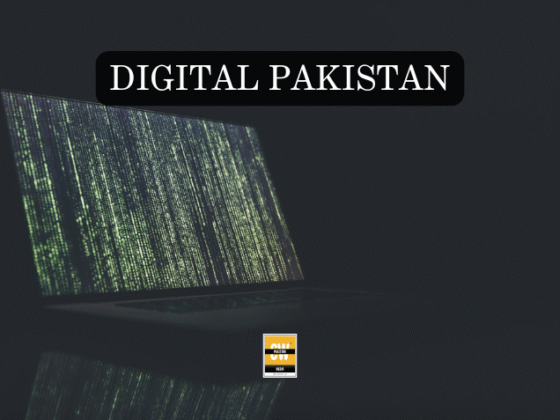As digital transformation accelerates across the globe, nations are increasingly focusing on building Digital Nations — countries where technology permeates governance, economic activity, and societal development. Pakistan is positioning itself to become one of these digital powerhouses. With its growing young population and increasing digital investments, the country is poised to unlock new economic, governance, and societal opportunities. This article outlines the current status of Pakistan’s digital ambitions, highlighting key developments, challenges, and the strategic roadmap ahead.
What is a Digital Nation?
A Digital Nation is one where technology is integrated into every facet of society, from governance and public services to business operations and societal engagement. Digital technologies like cloud computing, blockchain, and artificial intelligence enable faster, more efficient processes that drive transparency, reduce costs, and create accessible public services. Countries such as Estonia and Singapore have exemplified the economic and governance benefits of this model.
The global digital economy is expected to contribute $6.4 trillion to global GDP by 2025, with digital governance alone driving efficiencies that can reduce administrative costs by as much as 20% (McKinsey Global Institute, 2021). For Pakistan, embracing digital transformation is not just about adopting new technologies but about building a sustainable, inclusive, and growth-driven digital ecosystem.
National Digital Masterplan: Structuring Transformation
Pakistan’s roadmap to a digital future is being guided by the National Digital Masterplan, which outlines the integration of digital technologies across governance, business, and society. The success of this transformation depends on a multi-layered approach that includes strategic vision, governance structures, technological infrastructure, and robust implementation frameworks.
The creation of a Digital Governance Framework will be a key component in enabling Pakistan to harness the power of digital transformation. According to the World Bank, nations with established digital governance systems experience 10–15% faster economic growth. In Pakistan’s case, this framework will prioritize digital inclusivity, regulatory modernization, and the development of digital public infrastructure. Key components of this plan include a national digital identity system, e-governance services, and improved data exchange mechanisms that will promote transparency and public trust.
Key Milestones in Pakistan’s Digital Journey
Pakistan’s efforts toward digitalization have been marked by several notable steps. A pivotal development was the country’s involvement as a founding member of the Digital Cooperation Organization (DCO), aimed at promoting digital collaboration in the Middle East and South Asia. This partnership highlights Pakistan’s commitment to digital progress on the global stage.
The recent passage of the Digital Nation Pakistan Act, 2024, established a legal framework for the country’s digital transformation, with a clear vision to improve public service delivery, boost economic productivity, and modernize governance systems. The newly formed Pakistan Digital Authority (PDA) is now taking charge of implementing the National Digital Masterplan. In August 2025, the government appointed Dr. Sohail Munir as the PDA Chairperson and Dr. Muhammad J. Sear as a member, both for five-year terms. This marks the start of an organized, high-level approach to digital governance and program delivery. The authority’s remit spans national digital identity, e-government rollout, and stewardship of critical digital infrastructure.
Additionally, Raast, Pakistan’s national payment system, is undergoing structural reforms that extend far beyond leadership reshuffling. The system, originally launched as a low-cost payment rails initiative, is being redesigned to integrate with microfinance networks, retail payments, and cross-border remittances. The search for a new CEO is not just symbolic; it reflects the country’s intention to give Raast the same centrality that India’s UPI or Brazil’s Pix enjoy. With more than 70% of Pakistan’s economy still informal, Raast’s success could redefine financial inclusion, making secure, low-cost, and instant payments a reality for millions of citizens and businesses.
The Economic Potential of Digitalization
Digitalization holds immense potential for Pakistan’s economic growth. The country’s digital economy is projected to contribute 7–8% to GDP by 2025, with fintech, e-commerce, and digital services driving this expansion. According to the State Bank of Pakistan (SBP), investments in fintech alone have grown by 60% in recent years, reinforcing the sector’s pivotal role in expanding financial access.
Pakistan’s youthful, tech-savvy population amplifies these prospects. Yet, to realize this opportunity, the country must close its digital skills gap. More than 80% of tech-related jobs remain unfilled due to shortages in expertise, particularly in areas like artificial intelligence, data science, and cybersecurity (World Economic Forum, 2023). Without investment in workforce development, the promise of digitalization risks being undermined by a lack of skilled human capital.
Governance Improvements through Digitalization
The Pakistan Digital Authority (PDA) is central to transforming governance. By overseeing initiatives like the digital ID system and the roll-out of e-government services, the PDA is working to make services more efficient and citizen-centric. The digital identity system will allow seamless access to government services, reducing bureaucratic burden while boosting transparency.
Pakistan is also embracing blockchain technology to improve public sector transparency and reduce corruption. By securing public records through decentralized systems, the state aims to ensure accountability in everything from land registries to welfare disbursements.
Advancements in Digital Currency and Taxation
In financial innovation, Pakistan is pushing forward with Central Bank Digital Currency (CBDC) trials. The State Bank of Pakistan is testing digital currency models designed to cut transaction costs, enhance payment security, and improve financial inclusion in underserved areas.
At the same time, Pakistan is modernizing its taxation framework to ensure that digital businesses — including e-commerce platforms and fintechs — contribute fairly. These reforms aim to balance innovation with regulation, aligning Pakistan’s fiscal system with the evolving digital economy.
Geopolitical and Regional Context
Pakistan’s digital ambitions cannot be seen in isolation. India’s Aadhaar identity stack has given its citizens frictionless access to government services, while Bangladesh has fast-tracked digital governance across ministries. Gulf nations, meanwhile, are pouring billions into AI-driven smart nation projects.
Pakistan’s membership in the DCO and passage of the Digital Nation Pakistan Act, 2024, position it as a regional contender. But without sustained investment, regulatory clarity, and institutional discipline, it risks lagging behind neighbors that are rapidly digitizing both governance and economies.
Climate and Disaster-Resilience Angle
For Pakistan, digital transformation is not only economic but existential. The floods of 2022, 2024, and 2025 showed how vulnerable the country remains to climate shocks. SUPARCO’s satellite monitoring and NDMA’s geospatial dashboards are positive steps, while AI-enabled disaster early warning systems are being piloted to predict rainfall, river surges, and coastal erosion.
Scaling such systems will determine whether digital governance can truly shield Pakistan’s economy and citizens from climate catastrophe. In this sense, digitalization is not an optional modernization project but a survival tool in the age of escalating climate risk.
Private Sector and Startup Ecosystem
State-driven reform is one side of the story; entrepreneurs are the other. In 2025, Pakistani startups — from fintechs to insurtechs, healthtech to agritech — attracted record levels of investment, even as global venture capital slowed. P@SHA’s 2025 data shows Karachi, Lahore, and Islamabad emerging as strong startup hubs.
This ecosystem is no longer confined to payments or e-commerce. Healthtech startups are reimagining access to doctors in rural areas, while agritech platforms are enabling farmers to use satellite imagery and AI to improve crop yields. Insurtech firms are innovating on risk pooling and microinsurance, signaling that Pakistan’s startup scene is diversifying in ways that could reshape the wider economy.
Education, Health, and Workforce Transition
Building a digital nation requires more than infrastructure; it needs a workforce and citizens ready for the demands of the future. In education, platforms like Taleemabad and Edkasa are transforming access to learning, while universities such as LUMS, NUST, and PIDE are embedding AI and data science into curricula. Yet the digital skills gap remains stark: while the youth are connected via mobile internet, they often lack the technical literacy to transition into digital jobs.
In healthcare, AI-enabled diagnostic tools, blockchain-based medical records, and telemedicine platforms such as Sehat Kahani are expanding access in rural areas where doctor-patient ratios are critically low. Government experiments with digital vaccination registries and pandemic dashboards show that the foundation is being laid for a health sector that is both digital and data-driven.
The overlap with security cannot be ignored. Attacks on school networks or hospital systems not only disrupt vital services but also erode trust in the very idea of a Digital Nation. Embedding cybersecurity into education and health platforms is therefore essential. Protecting health records, securing online classrooms, and ensuring the integrity of edtech and healthtech systems are not optional add-ons — they are the foundations of resilience.
Infrastructure Gaps and Digital Sovereignty
Pakistan’s dependence on fragile undersea cable systems like SEA-ME-WE underscores a serious vulnerability. Disruptions in these cables have repeatedly caused nationwide outages, raising concerns about digital sovereignty.
With global debates over alternative Red Sea routes and the geopolitics of undersea infrastructure intensifying, Pakistan must diversify its connectivity. Expanding terrestrial fiber networks, investing in local data centers, and exploring satellite-based solutions will be key to insulating the digital economy from external chokepoints. Partnerships with China’s Belt and Road digital corridor could also play a strategic role.
Cybersecurity and National Defense
Cybersecurity is perhaps the most pressing blind spot in Pakistan’s digital journey. Ranked 111th globally in ITU’s preparedness index, Pakistan has already witnessed high-profile cyberattacks on NADRA, banks, and Raast. The financial costs run into millions annually, but the real price is in lost trust.
Yet cybersecurity is not just a governance concern; it is a matter of national defense. As defense systems increasingly rely on satellite data, AI-enabled surveillance, and digital command infrastructure, vulnerabilities in civilian networks can spill into strategic domains. SUPARCO’s satellites and defense-linked data pipelines must be shielded from intrusion as rigorously as financial systems. A Digital Nation cannot exist without a Digital Defense doctrine.
Building national CERTs, enforcing strong data protection laws, and investing in indigenous cryptographic and AI-driven cyber tools are therefore as critical as expanding broadband. Cybersecurity is no longer a side issue — it is the spine of Pakistan’s digital and defense future.
Focal Lens on the Future
Pakistan’s digital roadmap rests on three objectives: ease of living, ease of doing business, and ease of accessing government services. Guided by these, the government is investing in emerging technologies like AI and big data. The global AI market is projected to reach $300 billion by 2026, and Pakistan hopes to capture a share of this by prioritizing AI governance frameworks and sector-specific adoption in agriculture, healthcare, and education.
The establishment of the Pakistan Digital Authority and the National Digital Masterplan are foundational steps, but the journey is far from complete. Expanding infrastructure, strengthening cybersecurity, building skills, and ensuring inclusivity will determine whether Pakistan merely digitizes — or truly becomes a Digital Nation.
Follow the SPIN IDG WhatsApp Channel for updates across the Smart Pakistan Insights Network covering all of Pakistan’s technology ecosystem.
Pakistan’s Digital Transformation: Walking The Talk





